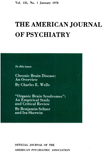PROGNOSTIC FACTORS IN RECOVERED AND DETERIORATED SCHIZOPHRENICS
Abstract
The case histories of two groups of schizophrenic patients with markedly different outcomes on follow-up were studied by one of us who did not know the outcomes. Of the 54 factors of possible prognostic significance that could be scored as present or absent, 11 were found that differed in the two groups at levels of significance of from p <.05 to p <.001. A scale was used that was made up of those eight of the 11 factors which differed in the two groups at the p <.01 or p <.001 levels. Of the 50 recovered schizophrenics 82 percent had scores of four or more and 80 percent of the deteriorated schizophrenics had scores of less than four.
Using an 11-factor scale and a computer method of discriminant functions, an only slightly higher discrimination was possible.
The study confirms Vaillant's simple method of prediction of schizophrenic remission and suggests that elaborate subclassifications of schizophrenia may be of less prognostic value than simpler methods which assign patients to a point on a prognostic continuum.
The importance of basing prognosis on longitudinal factors as well as on the clinical symptoms present at admission is emphasized. The need for considering prognostic factors in individual patients when evaluating various methods of treatment is apparent.
Access content
To read the fulltext, please use one of the options below to sign in or purchase access.- Personal login
- Institutional Login
- Sign in via OpenAthens
- Register for access
-
Please login/register if you wish to pair your device and check access availability.
Not a subscriber?
PsychiatryOnline subscription options offer access to the DSM-5 library, books, journals, CME, and patient resources. This all-in-one virtual library provides psychiatrists and mental health professionals with key resources for diagnosis, treatment, research, and professional development.
Need more help? PsychiatryOnline Customer Service may be reached by emailing [email protected] or by calling 800-368-5777 (in the U.S.) or 703-907-7322 (outside the U.S.).



